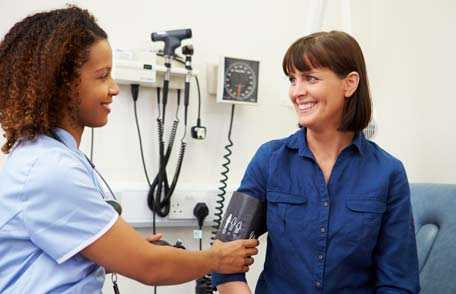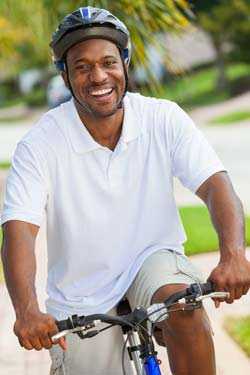Stop Stroke at Any Age
 You may think you’re too young to have a stroke—but stroke can strike at any age. In fact, about 1 in 7 strokes occur in adolescents and young adults, ages 15 to 49.1 Stroke is preventable and treatable. Learn to recognize the signs and symptoms of stroke, and call 9-1-1 right away if you think someone might be having a stroke. The sooner you get treatment, the better your chances of recovery.
You may think you’re too young to have a stroke—but stroke can strike at any age. In fact, about 1 in 7 strokes occur in adolescents and young adults, ages 15 to 49.1 Stroke is preventable and treatable. Learn to recognize the signs and symptoms of stroke, and call 9-1-1 right away if you think someone might be having a stroke. The sooner you get treatment, the better your chances of recovery.
A stroke, sometimes called a brain attack, occurs when a clot blocks blood flow to the brain (ischemic stroke) or when a blood vessel in the brain bursts (hemorrhagic stroke). Stroke is the fifth leading cause of death in the United States. The good news is that the overall number of strokes has gone down in recent years. But this is not true for a surprising number of adolescents and young adults.2
The Younger Face of Stroke
Stroke happens at any age, yet many young people do not think a stroke could happen to them. Younger people may not recognize the symptoms, and there may be delay in diagnosis at the hospital because stroke is typically thought of as a condition that happens to older people. Knowing the signs of stroke can help younger people get the treatment they need in time to prevent long-term damage.
Experts think younger people are having more strokes because more are obese, have high blood pressure, and diabetes. Living a healthier lifestyle (more physical activity and good diet) can help prevent a stroke.
These conditions raise your risk for stroke at any age:
- Obesity. More than a third of Americans older than 20 are obese.3Poor diet and lack of physical activity contribute to obesity and other conditions, such as high blood pressure and high cholesterol.
- High blood pressure. About one in four men and nearly one in five women ages 35 to 44 have high blood pressure, a leading cause of stroke.4
- Diabetes. About 1 in 11 Americans have diabetes. Prediabetes—when blood sugar levels are higher than normal but not high enough to be diagnosed as diabetes—is also on the rise among people older than 20. More than one third of U.S. adults have prediabetes.5

Minorities, especially African-Americans, have unique and increased risks for stroke at younger ages.
Certain groups of people are more likely to have a stroke at younger ages:
- Women. Some birth control pills can raise your risk for stroke, especially if you are older than 35 and you smoke. Complications during pregnancy from obesity or high blood pressure can also raise your risk. Women are also more likely than men to experience depression, anxiety, and stress—mental health conditions that raise the risk for stroke at any age.6
- Minorities. African-American men and women younger than 45 have almost twice the risk for stroke compared with white men and women in that age group. African-Americans are also more likely to die from stroke than whites.7,8 Hispanics also have strokes at younger ages than whites.9 The increased risk for stroke among African-Americans and Hispanics may be due in part to higher rates of diabetes, high blood pressure, and obesity.
Watch a video about an African American man who suffered a stroke at age 39
Stroke is Preventable
You can take steps to control your risk by making simple changes in your lifestyle:
- Check your blood pressure. You can check your blood pressure at a pharmacy or your doctor’s office. About one in three U.S. adults has high blood pressure, and many do not know it.
- Stop smoking. Smoking raises blood pressure and makes blood more likely to clot. Learn more about programs to help you quit smoking, such as CDC’s Tips From Former Smokers campaign.
- Get moving. Staying physically active keeps your blood vessels healthy and lowers your chances of having a stroke.
- Eat healthfully. Choose fresh vegetables, fruits, and whole grains and look for foods that are lower in sodium or salt. Too much salt in your diet can raise your blood pressure. Learn more about good nutrition choices in the 2015–2020 Dietary Guidelines for Americans .
- Lose weight. Being overweight or obese forces your heart to work harder and increases your chances of having a stroke. Talk to your doctor about making healthy changes to help you lose weight or maintain a healthy weight.
Act F.A.S.T. During a Stroke
If you think someone may be having a stroke, do the following simple test:
F—Face: Ask the person to smile. Does one side of the face droop?
A—Arms: Ask the person to raise both arms. Does one arm drift downward?
S—Speech: Ask the person to repeat a simple phrase. Is his or her speech slurred or strange?
T—Time: If you observe any of these signs, call 9-1-1 immediately.
Signs and Symptoms
Stroke signs and symptoms include sudden numbness–especially on one side of the body, confusion, trouble seeing or walking, and severe headache. If you or someone else experiences any of the signs or symptoms, act F.A.S.T. to get lifesaving medical treatment (see sidebar).
Stroke is Treatable
Stroke is treatable, but the most effective stroke treatments are only available if you recognize the symptoms of stroke and get to the hospital in time to get medical help. For some types of stroke, there is a three-hour window which a patient can be given a clot-busting drug (called tPA) that provides the best chances of recovering from a stroke.
What CDC is Doing
CDC supports several public health efforts that address stroke, including:
- Million Hearts®. Million Hearts® is a national initiative with a goal to prevent 1 million heart attacks and strokes by 2017. CDC and the Centers for Medicare & Medicaid Services co-lead the initiative on behalf of the U.S. Department of Health and Human Services.
- Paul Coverdell National Acute Stroke Program. CDC provides funding and technical assistance to nine states through a cooperative agreement to measure and track stroke care and to improve the quality of that care for all patients.
- WISEWOMAN (Well-Integrated Screening and Evaluation for WOMen Across the Nation). The WISEWOMAN program provides low-income women with chronic disease screenings, lifestyle programs, and referral services to prevent cardiovascular disease. CDC currently funds 21 WISEWOMAN programs, which operate on the local level in states and tribal organizations.
References
- Singhai AB, Biller J, Elkind MS, Fullerton HJ, Jauch EC, Kittner SJ, et al. (2013). Recognition and management of stroke in young adults and adolescents. Neurology; 81(12): 1089–1097.
- George MG, Tong X, Kuklina EV, Labarthe DR. (2011). Trends in stroke hospitalizations and associated risk factors among children and young adults, 1995-2008. Annals of Neurology; 70(5): 713–721.
- Centers for Disease Control and Prevention. (2015). Prevalence of Obesity Among Adults and Youth: United States, 2011–2014.
- Centers for Disease Control and Prevention. (2014). Power Down in May for National High Blood Pressure Education Month.
- Menke A, Casagrande S, Geiss L, Cowie CC. (2015). Prevalence of and Trends in Diabetes Among Adults in the United States, 1988–2012. JAMA; 314(10): 1021–1029.
- Centers for Disease Control and Prevention. (2016). Women and Stroke [268 KB].
- Kittner SJ, McCarter RJ, Sherwin RW, Sloan MA, Stern BJ, Johnson CJ, et al. (1993). Black-white differences in stroke risk among young adults. Stroke; 30: 1711–1715.
- Gillum RF. (1999). Stroke Mortality in Blacks: Disturbing Trends. Stroke.
Centers for Disease Control and Prevention. (2016). Hispanics and Stroke [216 KB].
More Information
More Information
- CDC Stroke
- National Institute of Neurological Disorders and Stroke (NINDS) Mind Your Risks campaign
- NINDS Stroke Information Page
- American Stroke Association
- National Stroke Association
- Youngstroke.org – a support organization for young adult stroke survivors
- Page last reviewed: May 2, 2016
- Page last updated: May 2, 2016
- Content source:
- National Center for Chronic Disease Prevention and Health Promotion, Division for Heart Disease and Stroke Prevention
- Page maintained by: Office of the Associate Director for Communication, Digital Media Branch, Division of Public Affairs




 ShareCompartir
ShareCompartir